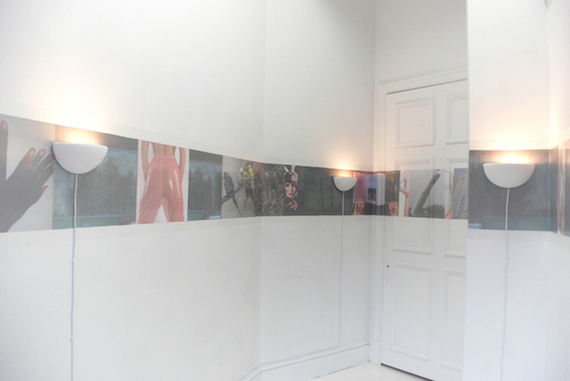"A Throw of Fifteen-Love", by multimedia artist Ariane Schick, opened Thursday at 55Gansevoort, a project space known for exhibiting renowned and upcoming artists including Aaron Bobrow, Jeanette Hayes and Betty Thompkins. This latest opening comes immediately following Schick's show, Casual Throws, at gallery Super Dakota in Brussels. While the title of her last exhibition referred to the comfy blankets that decorate the ends of sofas, "A Throw of Fifteen-Love" refers to score keeping in tennis. This serves as a reminder of the reciprocal, interdependent dynamics featured in her work, and perhaps even more so, it highlights the relationship of the work to the viewer, which bounces back and forth, much like the back and forth of a ball on a tennis court.
Like a spectator at a tennis match, a spectator of Schick's show also looks on from the outside in. All exhibitions at 55Gansevoort are fully visible, at all hours, by peering through the windowed doors. Upon peeking in, one first notices a strip of printed organza at eye level that ribbons the room's walls, doors, pillars and corners. It wraps entirely around the space, almost decoratively, enveloping it like a present. The continuous flow of images printed on the organza is a haphazard mix of interiors, exteriors and the human form. Gathered from Internet search results and personal pictures, they are lit up by rounded, store bought wall sconces, placed directly on the strip, obscuring some of the images and highlighting others. The sconces are placed at varied intervals, which sets a rhythm for the viewer's eyes to travel around the room in a continuous loop.
Jeffery: Can you describe the images featured on the organza ribbon?
Schick: The ribbon features a still from the Japanese film Tampopo, in which two embracing characters tip an egg yolk back and forth until its thin skin inevitably breaks. Stills and posters from the French film Maitresse show the protagonist, who spends the film exploring the limits between her two very different personas, in moments of transformation. The still of her in front of her mirror, its bare light in the foreground, is a throwback to the wall sconces in the space. The panel also features images of clothing items found on eBay. A picture of a pair of semi transparent vinyl trousers and figure hugging swimwear are modeled by disjointed, static, headless mannequins, highlighting the fact that what is cut off or not visible is just as important as what is clearly available to the eye.
Other images pull the viewer into a more historical context. These include an inflatable finger by situationist group Haus-Rucker-Co., whose work explored architecture through installations that altered perceptions of space. The image of Elsa Schiaperelli's trompe l'oeil gloves emphasizes the recurring theme of the boundaries between inside and out. There is a repetitive series of frames of a glass fence-like structure that holds back a hedge. Its green mass spills out over the top, while still visible through the fence's surface, which reflects the trees and electricity poles that face it. There are images of birds in a cage and a snapshot of flowers with sun glares that interrupt it.
An image of a building that features a large hole through which you can see the sky allows the viewer to slide from outside in. A chest of drawers holding a bonsai tree plays with limits and boundaries. A CGI image of a single pistachio nut shows two shells neatly separated. And finally, the open pages of a book called Silent Back (Dog), features images of puppy dogs' butts, held open by hands visible in the snapshot.
Jeffery: Can you describe the importance of the sconces sporadically placed on top of this imagery?
Schick: The sconces posit an air of, potentially, but not necessarily, domestic, casual informality. They push the image strip back to the status of a decorative element. They also play up the space, recognizing its needs, acknowledging both its specificities and its commonplace nature. They represent, in various direct and indirect ways, a blurring of perimeters and borders. They place the viewer at the center of a court of images and objects in which their display hovers between presence and absence in order to highlight the viewer in action.
The result of Schick's show is a site sensitive experience as the wallpaper-like strip flows across the room. The viewer slips between layers of available information as the ribbon beckons the eye to follow the strip in its linear form. Overall, the images project an unreliable feeling and their accumulation heightens this by flattening out and cancelling their singular importance as readable messages. The sconces placed on top of the images interrupt their flow and remove the feeling of the typical 'white cube' experience, as they evoke a more residential space. The title, "A Throw of Fifteen-Love", the linear form of the project, and its minimalistic simplicity, all hark on the experience of rules as a recurring theme in the artist's work. Ultimately, if Schick's goal is to put the viewer in a position where they question in what context they are seeing what is laid out before them and ask themselves, "How am I supposed to look at this?" then she has succeeded.
A Throw of Fifteen Love is open June 18th - July 12, 2015, 55 Gansevoort St, New York, NY, 10014, http://www.55gansevoort.com

